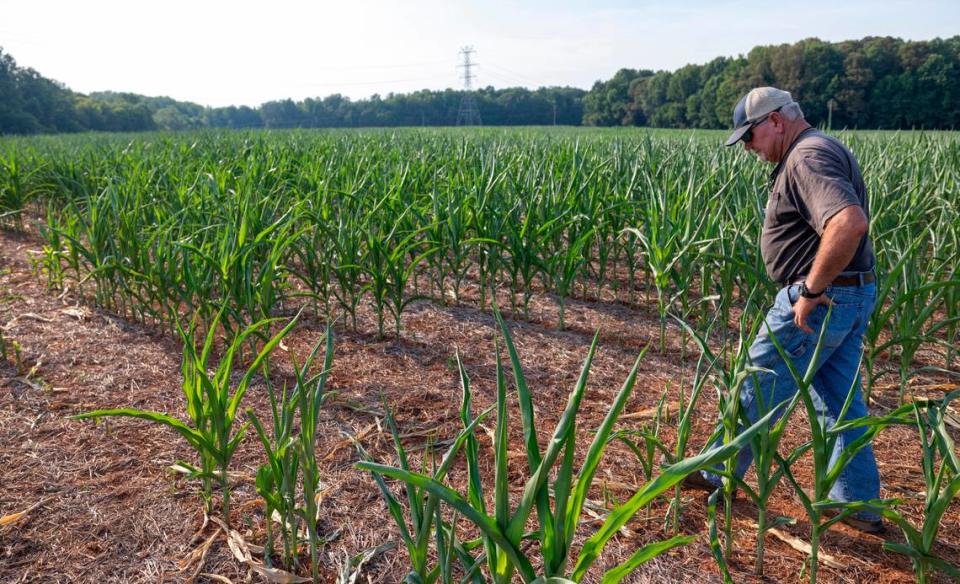‘It’s been a tough year.’ NC farmers look for solutions as corn crop withers in field.
The knee-high field corn at David McKee’s farm in Rougemont is green but stunted this week, its roots clinging to hard, red clay webbed with half-inch cracks and its leaves curled and twisted like day-old party streamers.
This time of year, field corn, grown for animal feed, ethanol and processed foods, like corn syrup and snacks, should be at least 7 feet tall and ready to sprout tassels and set ears. It could start growing again with a good steady rain, and so could the grass, which the cows have eaten to a nub, McKee said.
He put out a few hay bales for them this month, but that cuts into winter feed stores, and his soybeans could also take a hit if he misses Sunday’s planting deadline. Insurance already covers only some of his losses, and the amount is reduced if the plants go in late.
“If you put soybeans in the ground now, they’re going to bake in the ground and they will never sprout,” McKee said.
Most North Carolina farmers expect weather extremes, but the Piedmont and coastal areas haven’t seen rain in more than a month. It will take a lot to replace what they missed, McKee said.
Climate and economic experts agreed the repercussions could affect farms and consumers next year and into the future.
“It’s been a tough year, and it’s not even over yet,” McKee said.

Farmers need rain, cooler nights
Orange County is in its second-driest June on record since 1891, with 0.45 inches of rain reported at the Chapel Hill weather station, said Kathie Dello, director of the State Climate Office of North Carolina. The driest was in 1913, when 0.05 inches of rain fell, about 4 inches below the county’s normal precipitation level, she said.
On Thursday, the Drought Monitor posted a new update: 99 of 100 counties were experiencing dry conditions, with 57 upgraded to moderate drought and 42 designated abnormally dry. Most reported getting less than an inch of rain in June.
While summer vegetables can tolerate some heat, daytime temperatures over 90 and nights over 70 for a week or more can wilt and dehydrate plants, affecting pollination, production and flavor, N.C. Cooperative Extension officials said.
A recent spate of scattered showers brought temporary relief to some farmers across the state, but not enough to help crops recover. In eastern North Carolina, some farmers have given up, mowing their cornfields to start over, state field agronomists reported.
Smaller and local farms that can irrigate are getting by, said Cathy Jones of Peri-winkle Farm in Chatham County. There are “a lot of farmers working like crazy to save tomatoes” this summer, she said.
“We’re irrigating 24-7. It’s a nonstop process of getting water to different areas of our farm,” Jones said.
Her 33-acre farm produces flowers and seasonal vegetables each week for the Carrboro Farmers’ Market. They also plant cover crops, including buckwheat, cowpeas — also known as black-eyed peas — and sunflowers, in between vegetable rotations, but that’s next to impossible right now, Jones said.
The heat, especially at night, is “a double whammy,” she added. Plants mature faster, flowers can’t sleep, and tomatoes don’t set their fruit. They are rushing to get the potatoes out of the ground before they bake in the hot soil, she said.
The 2020 N.C. Climate Science Report says 2019 set the record for the warmest nighttime lows in North Carolina, capping off five years of the warmest overnight lows in 120 years of state historical records.
Climate change picking up steam
Researchers expect the global food supply to take more hits as the climate changes. The 2020 report noted overall crop yields could fall 3% to 7% in the Piedmont and mountain regions if carbon emissions aren’t cut. Coastal areas could see more extreme weather.
Climatologists also expect more “extreme heat” days (above 95 degrees) and more frequent extremes in precipitation, from severe droughts to storms, Dello and others said. Change could also bring new pests and more heat-related illnesses, especially for farmworkers.
North Carolina was behind the climate curve until the 1970s, warming by 1 degree from the 1890s to the 1960s, compared to 2 degrees globally. It has picked up in response to the changing climate, rapid deforestation and land-use changes, Dello said.
While that may not sound like much, it’s already a different North Carolina than our parents and grandparents knew and could result in a major agricultural shift, she said, affecting a $77 billion state industry and over 700,000 jobs.
That doesn’t mean we’re doomed, Dello said.
“Folks really recognize that something is happening, and the conversation has changed quite a bit, at least over the past five years, from is this real to what can we do about it, and there’s been a lot of emphasis on resilience,” she said.

Finding new crops, ways to grow
Research is underway statewide to find fruits and vegetables that grow better in heat and humidity and to tap regenerative farming, which uses different crops and methods to reverse climate change and build healthier soil.
The nonprofit Utopian Seed Project near Asheville is growing a variety of traditional and native Southern plants, aquatic plants and temperate tropical plants on micro-farms to build a resilient, diverse food supply. At N.C. State University, researchers are also involved in multiple projects, including crop rotation using sesame, which can be used to produce oil, food and cosmetics.
Smaller, local farms are exploring heat-tolerant crops, no-till soil management, climate-controlled hoophouses, high tunnels and shade covers, and other techniques to extend their seasons and increase food production.
In Bladen County, which produced over half of the state’s 38 million pounds of blueberries in 2022, one farmer is trying to find the best berries for a shorter, more challenging season.
Joseph Williams, manager of Blue River Legacy Farms, is consulting with Tim Glotfelty, a researcher with the State Climate Office, to grow 22 different varieties in a 2-acre test plot to find what grows best with reduced “chill hours,” but still has flavorful berries.
Blueberries go dormant in the winter and need a period of 32- to 45-degree weather to recharge, so they can develop new blooms and fruit when the days start getting longer. Winter heat spikes lasting more than a day or two disrupt chill hours, reducing the fruit.
The plants also don’t like highs above 70 degrees or humidity above 80%, he said, noting long, hot, dry summers and milder winters are reducing the traditional May to July season.
That forces N.C. farmers to compete with regions on a traditionally early schedule, creating market oversupply and cutting prices.
“We’re starting to see some impact of that, but the market will adjust to when fruit is available,” Williams said. “They just right now are in a state of confusion, and it’s a real struggle. We had some of the worst pricing probably in North Carolina ever.”
Cost to farm, buy food going up?
Triangle farmers markets reported there’s been no effect yet on the prices their farmers charge, but N.C. State University professor emeritus Mike Walden thinks consumers will be especially hard hit next year with a 25% increase in food costs, including for meat.
Other hard-hit crops could include tobacco, soybeans and peanuts, he said. Farmers who see profits reduced will have to charge more for what they send to market to cover the cost of doing business next year.
“When you’re dealing with nature, there’s not much you can do, so this is a good example of a situation in my opinion where we really need to understand our farmers and appreciate what they do, because they’ve got a tough job,” Walden said.
Orange County farmers McKee and Joe Phelps said it’s tough to get into farming or stay in business without a second income or a lot of land. Phelps, a part-time farmer and full-time Realtor, sells most of his corn to Durham’s Mystic Brewing for whiskey. The rest goes to granaries for animal feed.
Rain this week could save some of the local crop, Phelps said, but otherwise, this year could be a total loss.
“A good, heavy dew will relieve the corn some, but most mornings, the grass is still dry,” he said.
McKee plans to sell off his calves, which are “bringing more money than they’ve ever brought in my lifetime,” to cut costs. And by July 30, he needs to plant the next cornfield, in time to grow the McKee Cornfield Maze, which attracts thousands of people to the farm.
If that corn doesn’t grow tall, his wife Vickie has a plan.
“It may not be a cornfield maze,” Vickie McKee said. “It may be a labyrinth.”
In the Spotlight designates ongoing topics of high interest that are driven by The News & Observer’s focus on accountability reporting.


